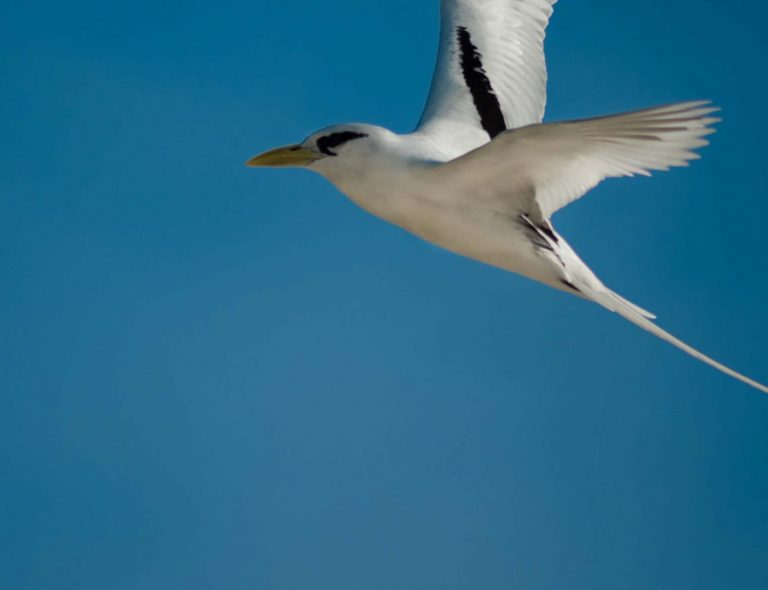HURRICANES ARE A GREAT TIME TO PULL OUT THE BINOCULARS
By HEATHER WOOD
One might assume that a bird facing the winds of a 140mph storm would end up on the losing end.
Nature, however, has given even seemingly helpless creatures the ability to protect themselves in such weather.
“Landbirds in home territories are surprisingly resilient, surviving during and immediately after a hurricane, or any extreme winter storm, because they instinctively know where is best to take shelter,” said David Wingate, an ornithologist and former Government conservation officer. “People often comment to me how their garden birds reappear as before, unscathed.”
In actuality it is the period after the storm that presents birds with a bigger problem. Many rely on foliage which burns off and dies, taking insects along with it.
Said Dr Wingate: “Ground feeders do better than foliage gleaners because insects and worms don’t die in soil. Worst affected in Bermuda is our white-eyed vireo – chick of the village – which is exclusively a foliage feeder.”
Seabirds, especially the truly oceanic feeding species like petrels, shearwaters and tropicbirds such as the longtail, are not affected at all by hurricanes when at sea, he added.
“They thrive on the free energy of the wind and can easily ride it out or move out of the way.
They suffer worst on their breeding grounds – or at least their chicks do. Beach or low-lying islet nesters like our common tern, and cliff-hole nesters like our longtail and cahow, get washed out by the ground swell.”
Cahows, he explained, are “mostly spared” because they are winter nesters and miss the hurricane season which runs from June until November each year.
“The brief period of overlap is in late October/early November. This is an unnatural phenomena anyway, resulting from their early-history displacement by man from their optimum soil burrow breeding habitat inland, to holes in the cliffs on small low lying islets.”
Bermuda common terns, which nest here each summer, have typically suffered the most as a direct hit by a hurricane causes “total breeding failure”. That hurricanes are increasing in severity and frequency as a result of global warming makes their plight even more concerning, Dr Wingate said.
“Indeed our common terns have been declining steadily from this cause in recent years and are now our rarest nesting seabird with only four pairs left in 2021. However, on the brighter side they are now being replaced on Bermuda by the roseate tern because that species is adapted to survive better in hurricanes.”
If caught over the ocean, migrant landbirds do not fare well during hurricanes.
“Bermuda being a small oceanic islet situated far at sea downwind from North America is best positioned to witness this, because millions fly over the island on a shortcut flight to South America, which lies mostly east of North America – in fall,” Dr Wingate said. “A study I made using the Q6 radar mounted on Cooper’s Point to track the ‘man on the moon’ mission, revealed that most of these birds fly over us nonstop, even when they can obviously see the island below them. This is a good thing because otherwise we would be knee deep in birds during the fall migration, and the birds would not benefit because they would quickly consume all food supplies, use up their fat supplies laid on for long distance migration – and starve to death.”
Despite that, there are three factors which together “cause a huge landfall phenomena in hurricanes passing near or over Bermuda”, Dr Wingate said.
- Landbirds caught over the ocean are drifted off course by hurricanes. Desperate to escape the winds, if they come within sight of Bermuda they land.
- There exists an “island concentration effect” which is proportionate to the ratio of the island’s land area divided into the area of ocean from which it can be seen. As the former is generally constant, this means that the smaller the island, the greater the concentration.
- On occasions where the hurricane eye passes directly over Bermuda, the wind-drifted birds become stuck inside it and use the island as a refuge.
“Shame to say this has led our keener birders to pray that the hurricane will hit us direct – if it is going to come near us anyway – because the opposite seems to occur if the eye misses us,” Dr Wingate said. “I call this opposite situation the ‘eye shadow effect’, and it is manifested best whenever a hurricane passes between Bermuda and the continent, because most of the birds are swept past us, island unseen, in the fog of rain and salt spray.”
The aforementioned combination has led to “some truly spectacular fallouts”, he added.
“The most notable, back in the days when all birds were much more abundant, was [on October 8, 1948] right at the peak of fall migration, when the gardeners for Cambridge Beaches hotel are said to have raked up barrels of dead birds, and the September hurricane of 1987 – which I experienced – when Bobolinks were seen in the thousands covering our golf courses, and 17 of the rarely observed Connecticut warbler were flushed from just one weedy agricultural field.
“Eighteen other species of warblers were seen by the hundreds or thousands after that storm, easy to see in the fallen casuarinas. They were so desperate for food that they were landing on my legs to capture spittal bugs off the fallen casuarinas! Many a keen birder would give an arm and a leg to have this experience!”

